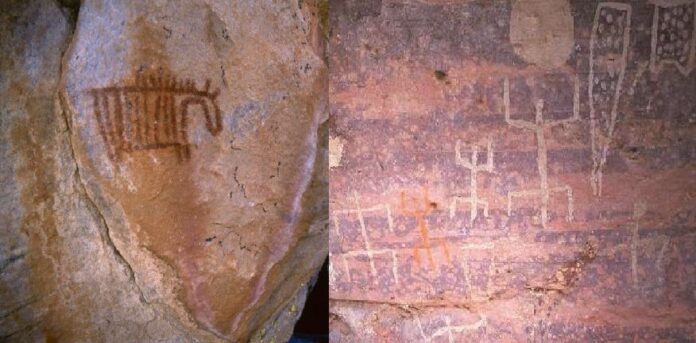Notwithstanding, apart from the commended agrarian stone art made by the San (or Bushmen), southern Africa has various later stone art customs made by African cultivating networks.
The broadest of these customs as far as the region covered several destinations is the stone art of the Northern Sotho, which tracks down spread across most of northern South Africa.
Recognition of Northern Sotho Stone Art
Northern Sotho stone art is effortlessly recognized from San rock art by its tone and structure.
It is transcendently executed in white and was applied thickly onto the stone by finger (as opposed to the polychrome brushwork artworks of the San).
Sporadically, the artists also utilized red and dark shades as adornment over the essential white plan.
The white utilized is a type of powdered dirt found in numerous riverbeds nearby.
The decision of white as the dominant color is regular for rock art customs having a place with African agriculturists.
These arts have become conversationally known as the ‘late whites.’
Northern Sotho art exists in its most central fixation in the more remote slope spaces of Limpopo Province, South Africa.
Regions particularly wealthy in this art incorporate the Soutpansberg and Waterberg mountains also of the Makgabeng level.
Altogether almost 300 locales with Northern Sotho stone art are right now known.
The prior and a later period of Northern Sotho stone art
The art separates into an initial and a later period. The early art portrays a scope of wild creatures like elephants, zebra, lions, rhino, kudu, hyenas, and hippo, yet the prevailing subject is the giraffe.
Practically, the ancient artists disguised all of the art in huge stone asylums in remote and isolated mountain regions.
These spots are the customary settings for the cryptic Northern Sotho young men’s introduction rehearses.
Elderly folks in specific areas recognize a connection between this art and customary inception rehearses.
However, they express that, while a portion of the painted destinations are as yet utilized for commencement functions today, the practice of making rock art has stopped.
It appears to be that each painted creature conveyed an exceptionally informative and representative message.
The young men’s introductory arts and signs regarding how this imagination operated proceeded with utilizing imagery creatures in present-day inception rehearses.
The advanced version of the art holds up the following, for instance:
- the fire sometimes alluded to as the lion offspring
- the enchanted tree as the giraffe
- the cairn of stones as the hyena, and
- The design under which food represents the elephant
A significant number of the educational tunes learned by the stars are likewise worried about these equivalent creatures.
People regularly muddle the mysterious lessons in these melodies to the last.
However, disguised in this perplexing depiction of creature symbolism, social messages become logically perceived through existence with age and experience.
With the Difaqane and afterward the happening to white ranchers to Limpopo Province in the nineteenth century, life changed drastically for the Northern Sotho.
Expenses, wars, and land clearances left numerous destitute and dejected.
Recently, the entire population escaped to slope regions for well-being.
Bottom End
Large numbers of the old founding locales became asylum houses, and the stone art mirrors these changes.
The later art is overwhelmed by portrayals of steam trains, troopers, pilgrims, and firearms.


